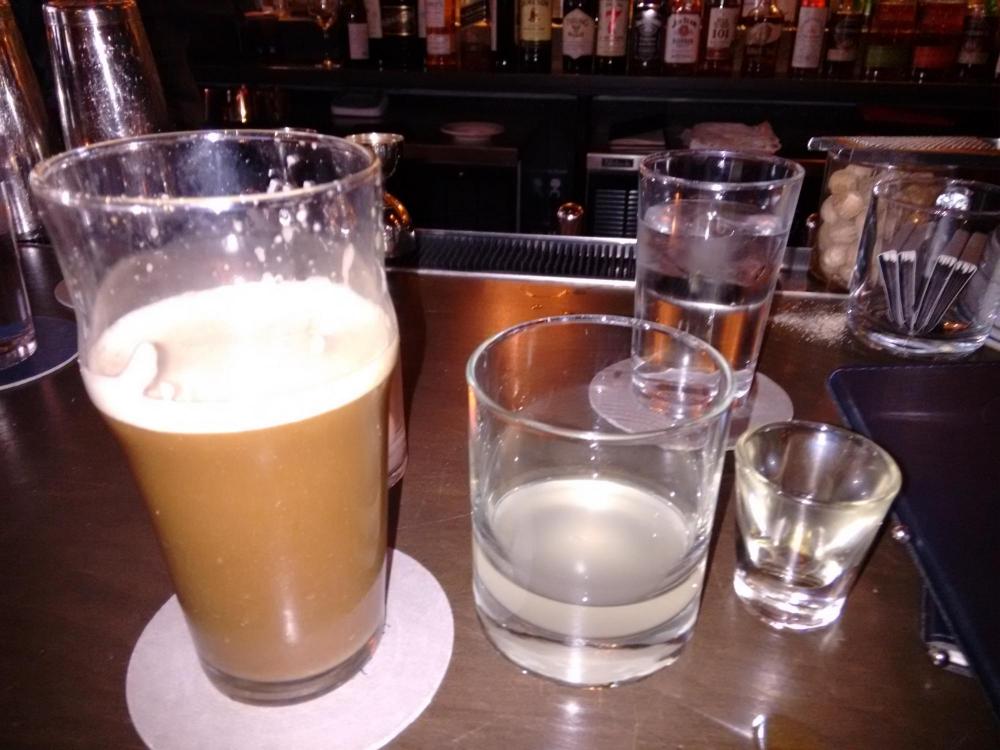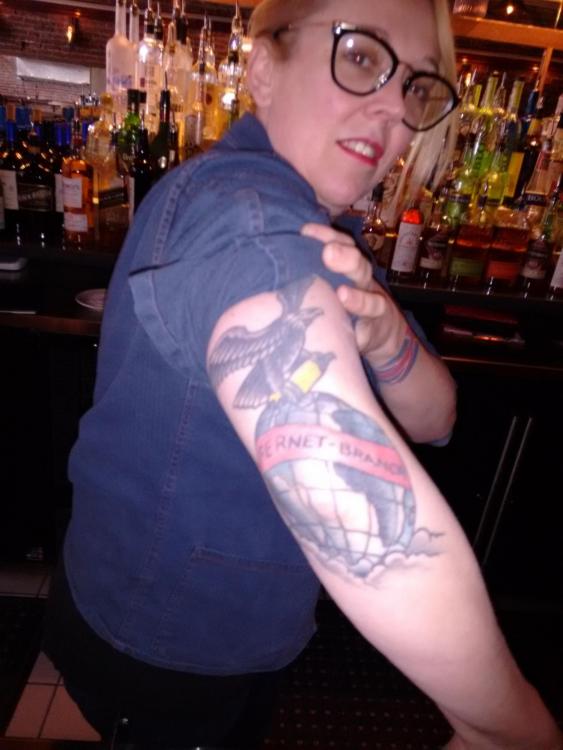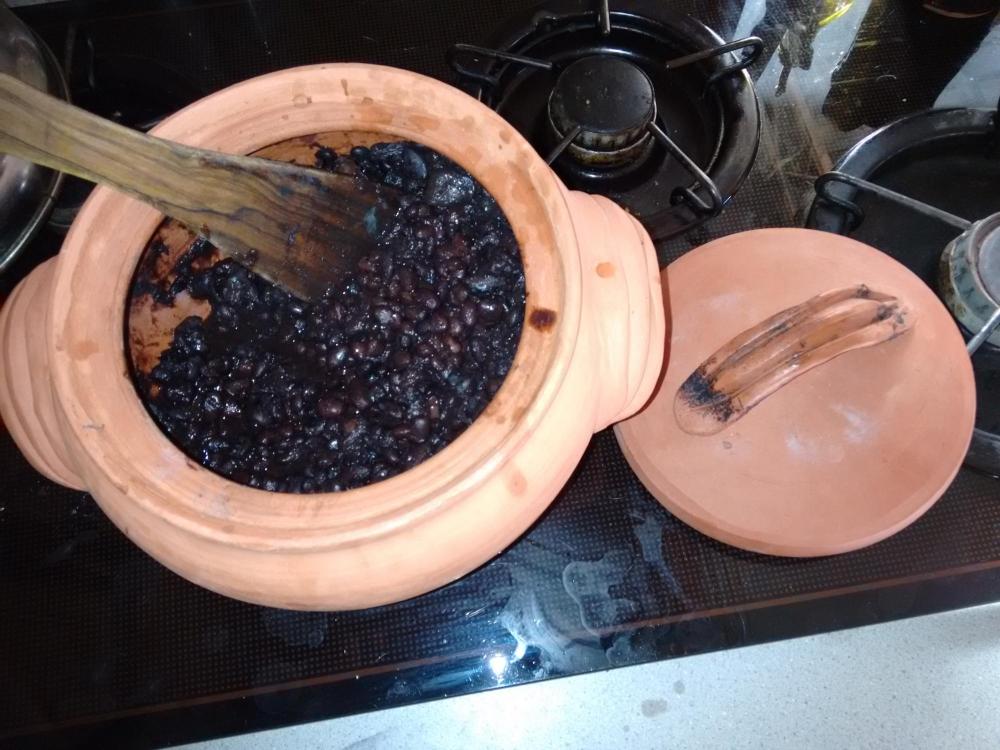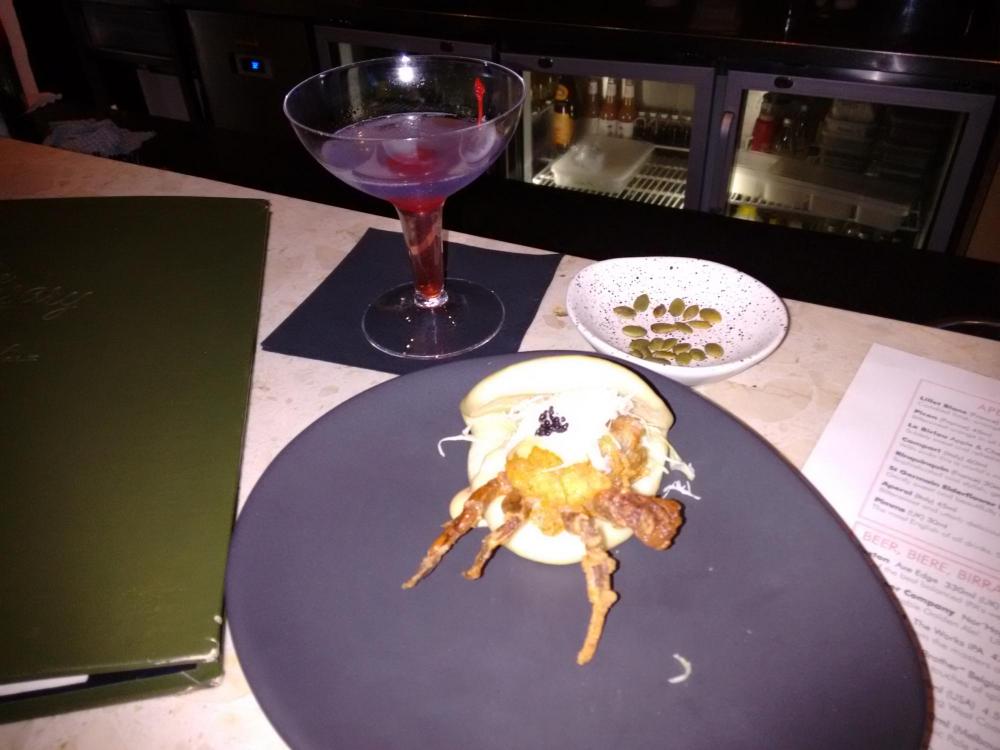-
Posts
2,431 -
Joined
-
Last visited
Content Type
Profiles
Forums
Store
Help Articles
Everything posted by haresfur
-
How to recognize a good cocktail bar: when you ask for shots of Fernet and the bartenders join you. But the highlight was my Tyrone with scotch, banana liqueur, egg white, something else that I forget (my photo of the menu didn't turn out) and stout garnished with nutmeg. A flip for people who would freak at egg yolk. For my second drink, I asked for something with Smith and Cross and got a tiki-esque drink with a nice punch that they were working on. I think I'm slowly converting my wine-drinking cousin and her boyfriend. All this and more could be yours at Quarter and Glory in Washington DC. New enough that they don't serve food yet. They are off to a great start.
-
I re-purposed an unglazed terracotta pot I made for Romertopf style oven cooking as a stovetop bean pot. The black beans cooked with onion, garlic, a little cumin and salt turned out great. The pot didn't suffer any thermal shock issues on the gas stove with no diffuser. I can't remember for sure but I think I fired the pot to cone 06 since I wanted to balance porosity and strength.
-
I deconstructed a belted galloway shoulder roast (I think shoulder - the poor thing had been through the wringer. My beef dude had told me that it should be roasted slow because of some tough tissue through the middle. Luckily he vac packed it because it went through refrigerator death, resurrection, and redeath then sat in my lab fridge at work (shh) until I got a replacement and then it sat at home for a while until I got around to cooking it). I cut out fat and anything that didn't look like meat, kind of unwinding it into a couple of thin pieces and a thicker one then into the sous vide at 58 C for about 2 hours. The thin pieces went into a stir fry and the thicker into the freezer. Nice cut. meaty but not too meaty and soft but not mushy. Maybe I'll turn the remaining bit into an odd-shaped beef wellington.
-
My DB will never again wrap a bamboo steamer up in plastic to keep 6 legged critters out after cleaning and seemingly drying (I hope). However we may have discovered new media for culturing fungi.
-
So you don't want to try something like these?
-
Went to The Dispensary here in Bendigo for an ok aviation. I would have cut way back on the Violette and bumped the lemon. Didn't recognise the Violette brand and forget what the bartender said, but she did say they could get a bottle for me. I told her that I might as well have them keep making the drinks, given how long it would take me to go through a bottle. The steamed soft shell crab buns more than made up form my fussiness regarding the drink.
-
I planned blueberry waffles for breakfast, even though it turned out the berries were insanely expensive. Funny thing though, my DB is the master waffle-maker
-
There's a Cibo Matto song, White Pepper Ice Cream. I love the song so the ice cream must be good.
-
I'm a latecomer to being able to stand mashed potatoes. Baking instead of boiling is a new one on me. I thought one of the reasons to start boiling with cold water was to promote enzyme reactions and I wonder if this occurs in the baking. I usually boil a waxy variety with the skin on, drain and let dry as they cool some, then rice leaving the skin behind, and gently fold in sour cream. Butter - yuck.
-
I don't mind experimenting. It will certainly be drinkable if your substitution is close. If it is really different, you may find an even better drink. And in between, you will learn how to adjust amounts to get a balance you like.
-
Nothing too bopping. I chopped the end of my finger off while listening to the English Beat and prepping.
-
Death of the Fridge Campari over very soft lemon gellato.
-
I don't do the chill in my Search for the Perfect Parma. A sear in really hot rice bran oil seems to crisp the breading just fine without cooking the chicken further. Since I do the chicken at a 58 C, There is quite a bit of room for the surface to firm up a bit anyway.
-
I confess that I can't really tell the difference when I use Fees Barrel aged bitters instead of the equivalent non-barrel aged ones, so I'm a skeptic about the whole idea.
-
I just want to hug the round red one with the black smudge near the back (then cook something in it).
-
I cut through the tendons for domestic turkey and chook legs. The contraction helps keep the meat tender. The tendons pretty much dissappear from chicken legs, but even with that I had to cut the meat from the turkey tendons. I suppose whacking the ends of the legs would work as well - not as pretty but probably more fun to do.
-
One of my father's many strange but pretty innocent ones: He took us to a pre-Christmas special, more or less Victorian, meal in the upstairs of a beautiful old stone restaurant. The kind of affair where they sing the food in with carols, etc. The halls were decked with holly and the long wood tables had runners down the middle with ribbons and holly and scattered with decorative nuts. As we conversed, waiting for the meal to be served, he almost absent-mindedly proceeded to crack the walnuts loudly against each other and nibble on the nut-meat. Hey, they shouldn't put appetizers out if they don't want you to eat them, right?
-
Just remember to take it out of the sink where it is chilling and put into the fridge before you go to bed.
-
I suppose the mature way to deal with it would be to get up from the table, find someone in charge and quietly let them know things are going to heck. That would give them the chance to try to salvage the rest of the meal - a win-win (or perhaps a draw). It would also give them a chance to make financial accommodations if they see fit. But it would have to be really far below acceptable for me to think you could walk out without paying at any place.
-
He's a food critic. His job is to tough it out, wait for the wine glasses to be filled, and eat fancy food that may taste ok but doesn't meet expectations. It's rough but someone has to do it.
-
The price increase issue is an interesting bit of psychology. You can't eat a 2009 Per Se meal today, the old prices shouldn't really matter. Value for dollar can't increase forever, eventually you run out of people to screw out of their share. I suppose it is good to leave some room to improve, or at least make things different. But maybe as a place matures it needs to morph from the new and exciting to the trusted and true.
-
Almost sounds like the waitstaff don't like the no tipping policy. Except for the poor review of most of the food. But really the price increase isn't that far out of line with inflation since tip is now included, and probably in the noise since you shouldn't apply the same factor to all industries.
-

Your Daily Sweets: What Are You Making and Baking? (2015 – 2016)
haresfur replied to a topic in Pastry & Baking
The plums were early and small this year, but we came across them at the farmer's market and made my father's plum cake.- 486 replies
-
- 11
-







.thumb.jpg.08d6fb7ceaa4badd786d43843df62750.jpg)